Birds in the News #36
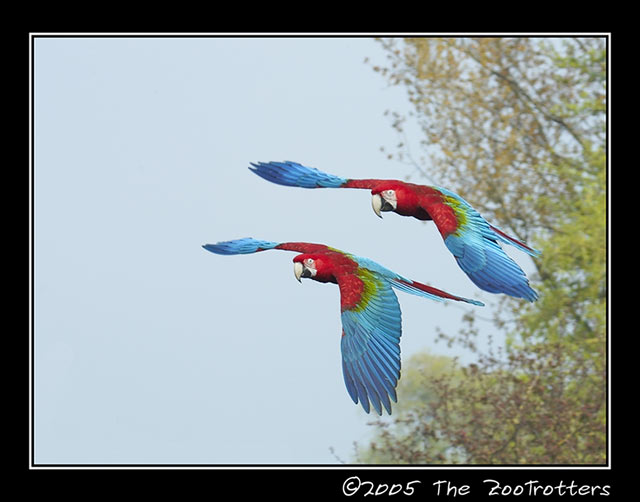
Greenwing Macaw, Ara chloroptera.
Birds in Science:
In the Solomon Islands, east of New Guinea and northeast of Australia, lives the monarch flycatcher, a medium-size songbird, which is refining our understanding of evolution. Curious about how new species arrive on islands, Chris Filardi, a University of Montana visiting scholar, began gathering DNA samples from the flycatchers and reconstructing relationships between the birds on the islands and on the island’s nearest continents. What he and co-researcher Robert Moyle discovered was that islands are much like a petri dish that sprouts its own biodiversity. Contrary to conventional thinking, the scientists, both of whom work for the American Museum of Natural History’s Center for Biodiversity and Conservation, have found evidence that islands are not evolutionary dead ends, but can actually be sources of new species. “If we keep getting this kind of result, it will be relevant for the whole world,” Filardi said. “And because of that, we will have to think differently about islands everywhere and what we do with them.” This study was published last week in the top-tier research journal, Nature.
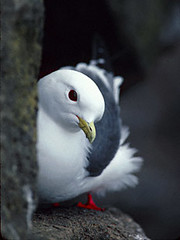 A change in the diet of seabirds may be making them less intelligent and lowering their chances of survival and breeding, a new study shows. Scientists used lab experiments to mimic changes observed in the diets of kittiwakes in the Bering Sea - changes probably caused by a warming ocean. Chicks given a diet low in lipid-rich fish were less able to find food. The 1980s saw the start of a decline in populations of red-legged kittiwakes, Rissa brevirostris (pictured), on the Pribilof Islands in the southeastern Bering Sea, off the coast of Alaska. The cause has been unclear, though scientists have documented a change in their diet that occurred around the same time. Around the coast of the UK, some sea bird populations are in catastrophic decline, also due largely to the removal of high-lipid prey such as sand eels. This appears also to be linked with climate change. The study is published in the Royal Society’s science journal Proceedings B.
A change in the diet of seabirds may be making them less intelligent and lowering their chances of survival and breeding, a new study shows. Scientists used lab experiments to mimic changes observed in the diets of kittiwakes in the Bering Sea - changes probably caused by a warming ocean. Chicks given a diet low in lipid-rich fish were less able to find food. The 1980s saw the start of a decline in populations of red-legged kittiwakes, Rissa brevirostris (pictured), on the Pribilof Islands in the southeastern Bering Sea, off the coast of Alaska. The cause has been unclear, though scientists have documented a change in their diet that occurred around the same time. Around the coast of the UK, some sea bird populations are in catastrophic decline, also due largely to the removal of high-lipid prey such as sand eels. This appears also to be linked with climate change. The study is published in the Royal Society’s science journal Proceedings B. A deep-voiced black-capped chickadee, Poecile atricapillus (pictured), may wonder why other birds ignore it, but there may be a good reason behind the snub, says a University of Alberta study that looked into how the bird responds to calls. Dr. Isabelle Charrier and Dr. Chris Sturdy modified the
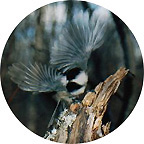 black-capped chickadee calls, played those sounds back to the bird and observed how they reacted. They found that the chickadee relies on several acoustic features including pitch, order of the notes and rhythm of the call. They also rejected the calls of the control bird, the gray-crowned rosy finch, in favor of their own species. The chickadees’ two most well-known vocalizations are the “chick-a-dee” call and the “fee-bee” song. Males produce their song to attract a mate and to defend their territory during the breeding season. The learned call is produced by both sexes throughout the year and is believed to serve a variety of functions such as raising mild alarm, maintaining contact between mates and co-ordinating flock activities. They even go through stages of learning this “song language,” which explains why juvenile birds can be heard frantically practicing to perfect this call. In this study, the researchers found that if they raise the pitch, the bird would still respond, but if they lowered it, the chickadee stopped answering. “We speculate that this happens because the pitch may be related to size, so the chickadee thinks, ‘wow, that bird sounds big,’ and they stay away from it,” says Sturdy, co-author of the study. “The first thing birds use to identify vocalizations is the frequency range. Different birds use different acoustic ranges as a filter, so if it is too high or too low, they ignore it.” This research is published in the current edition of the research journal, Behavioural Processes.
black-capped chickadee calls, played those sounds back to the bird and observed how they reacted. They found that the chickadee relies on several acoustic features including pitch, order of the notes and rhythm of the call. They also rejected the calls of the control bird, the gray-crowned rosy finch, in favor of their own species. The chickadees’ two most well-known vocalizations are the “chick-a-dee” call and the “fee-bee” song. Males produce their song to attract a mate and to defend their territory during the breeding season. The learned call is produced by both sexes throughout the year and is believed to serve a variety of functions such as raising mild alarm, maintaining contact between mates and co-ordinating flock activities. They even go through stages of learning this “song language,” which explains why juvenile birds can be heard frantically practicing to perfect this call. In this study, the researchers found that if they raise the pitch, the bird would still respond, but if they lowered it, the chickadee stopped answering. “We speculate that this happens because the pitch may be related to size, so the chickadee thinks, ‘wow, that bird sounds big,’ and they stay away from it,” says Sturdy, co-author of the study. “The first thing birds use to identify vocalizations is the frequency range. Different birds use different acoustic ranges as a filter, so if it is too high or too low, they ignore it.” This research is published in the current edition of the research journal, Behavioural Processes.Birds in Education:
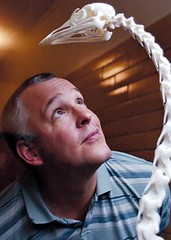 Professor David Hall, a handful of undergraduate research students and a volunteer taxidermist named Miles Stelios, have been working on a teaching collection of stuffed birds and skeletons for his undergraduate biology classes. Most of the birds in Hall’s collection died of natural causes, or were found dead after accidents such as flying into windows. These birds bodies are prepared and used for teaching and public outreach. “Outreach is what makes me feel all warm and fuzzy,” Hall said. “As a lecturer, I try to get more job satisfaction. I want to use it for teachers to improve science education in Texas, to get people interested in conservation and biology in general. It’s a huge benefit.” Most of Hall’s work for the collection has been on his own time, since, as he says, the University puts more funding toward research than materials for teaching. GrrlScientist says; this is a long but very interesting and worthwhile story, and the photographs are beautiful.
Professor David Hall, a handful of undergraduate research students and a volunteer taxidermist named Miles Stelios, have been working on a teaching collection of stuffed birds and skeletons for his undergraduate biology classes. Most of the birds in Hall’s collection died of natural causes, or were found dead after accidents such as flying into windows. These birds bodies are prepared and used for teaching and public outreach. “Outreach is what makes me feel all warm and fuzzy,” Hall said. “As a lecturer, I try to get more job satisfaction. I want to use it for teachers to improve science education in Texas, to get people interested in conservation and biology in general. It’s a huge benefit.” Most of Hall’s work for the collection has been on his own time, since, as he says, the University puts more funding toward research than materials for teaching. GrrlScientist says; this is a long but very interesting and worthwhile story, and the photographs are beautiful.People Hurting Birds:
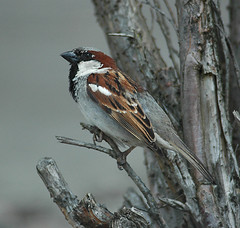 This story wins the award for the most unbelievably disgusting display of human stupidity and cruelty in 2005. This week, a sparrow flew into an exhibition hall in Amsterdam, became trapped and then panicked, knocking over 23,000 dominoes that had been set up for a new world record attempt. The terrified and defenseless bird was cornered and then shot dead by an exterminator packing an air rifle. The miscreant was a House Sparrow, Passer domesticus (pictured), an endangered species in the Netherlands. “Under Dutch law, you need a permit to kill this kind of bird, and a permit can only be granted when there’s a danger to public health or a crop,” said Dutch animal protection agency spokesman, Niels Dorland. The Endemol Production company, the dumbass TV firm that organized the event, attempted to defend their inexcusable revenge killing. “That bird was flying around and knocking over a lot of dominoes. More than 100 people from 12 countries had worked for more than a month setting them up,” said Endemol spokesman Jeroen van Waardenberg. BooHooHooHoo. So besting their own world record is more important than a life? How far would they stoop to protect their silly world record, a record they already hold? Fortunately, the Dutch animal protection agency plans to submit the case to prosecutors. A Dutch website, Dodemus.nl, is dedicated to collecting people's reactions to the death of this sparrow. So far, more than 4,000 have been posted.
This story wins the award for the most unbelievably disgusting display of human stupidity and cruelty in 2005. This week, a sparrow flew into an exhibition hall in Amsterdam, became trapped and then panicked, knocking over 23,000 dominoes that had been set up for a new world record attempt. The terrified and defenseless bird was cornered and then shot dead by an exterminator packing an air rifle. The miscreant was a House Sparrow, Passer domesticus (pictured), an endangered species in the Netherlands. “Under Dutch law, you need a permit to kill this kind of bird, and a permit can only be granted when there’s a danger to public health or a crop,” said Dutch animal protection agency spokesman, Niels Dorland. The Endemol Production company, the dumbass TV firm that organized the event, attempted to defend their inexcusable revenge killing. “That bird was flying around and knocking over a lot of dominoes. More than 100 people from 12 countries had worked for more than a month setting them up,” said Endemol spokesman Jeroen van Waardenberg. BooHooHooHoo. So besting their own world record is more important than a life? How far would they stoop to protect their silly world record, a record they already hold? Fortunately, the Dutch animal protection agency plans to submit the case to prosecutors. A Dutch website, Dodemus.nl, is dedicated to collecting people's reactions to the death of this sparrow. So far, more than 4,000 have been posted. Bird Flu News:
Why would anyone want to resurrect a long-dead flu virus? This is the question that the public commonly asks regarding research into the 1918 flu virus that killed millions of people worldwide. But the genetic sequence from the virus has the potential to help us develop vaccines that might help protect humans from another pandemic. However, recently reconstructed 1918 virus surprised researchers with its weird genetic sequence. Dr. Jeffery Taubenberger, a molecular pathologist at the Armed Forces
 Institute of Technology who led the research team that reconstructed the long-extinct virus, said that a few things seemed clear. First, the 1918 virus appears to be a bird flu virus. Second, if this virus originated in a bird, it is not a species that anyone has studied before. It is not like the H5N1 strain of bird influenzas in Asia, which sickened at least 116 people, and killed 60. Additionally, it is not like the influenza viruses that infect wild waterfowl in North America. Yet many researchers still believe that the 1918 virus, which caused the worst infectious disease epidemic in human history, is a bird flu virus. If so, it is the only “bird flu” virus that has ever been known to cause a human pandemic. That, Dr. Taubenberger said, gives rise to a question. Are scientists looking for the next pandemic flu virus in all the wrong places? Is there a bird species that no one ever thought about that harbors the next 1918-like flu? And if so, what bird is it, and where does it live? [pictured: electron micrograph of Influenza viruses]
Institute of Technology who led the research team that reconstructed the long-extinct virus, said that a few things seemed clear. First, the 1918 virus appears to be a bird flu virus. Second, if this virus originated in a bird, it is not a species that anyone has studied before. It is not like the H5N1 strain of bird influenzas in Asia, which sickened at least 116 people, and killed 60. Additionally, it is not like the influenza viruses that infect wild waterfowl in North America. Yet many researchers still believe that the 1918 virus, which caused the worst infectious disease epidemic in human history, is a bird flu virus. If so, it is the only “bird flu” virus that has ever been known to cause a human pandemic. That, Dr. Taubenberger said, gives rise to a question. Are scientists looking for the next pandemic flu virus in all the wrong places? Is there a bird species that no one ever thought about that harbors the next 1918-like flu? And if so, what bird is it, and where does it live? [pictured: electron micrograph of Influenza viruses]Incidentally, the parrot that was thought to be the UK’s first victim of bird flu probably did not have the virus, it was finally reported earlier this week. A Department for Environment Food and Rural Affairs report admitted that a mix-up in samples taken from a quarantine center where several birds died led to the South American parrot being suspected of bringing the killer virus into the country and of being its first fatality. It now appears that the only birds to be infected at the centre in Essex came from a consignment of finch-like mesias, Leiothrix argentauris, imported from Taiwan. Samples taken from a mesia that died and from the Amazon parrot from Surinam, who died in an adjoining cage at the Pegasus Birds center, became mixed up, leading the testing laboratory wrongly to conclude that the parrot was the source of the H5N1 bird flu strain. The report says that 53 of 101 mesias died in quarantine. It was also found that the virus was not passed on to other bird species being held at the center - a fact that Ben Bradshaw, the animal welfare minister, hailed as having “potentially huge implications” for international efforts to tackle avian flu. GrrlScientist note: Why is this story not even mentioned in any of the newspapers in the USA, and it was barely even mentioned in the UK, even though the original story received so much press coverage? And why did it take almost one month for this story to appear in the British papers? (The mix-up was first reported to have occurred on 26 October and this story was published on 16 November). Perhaps ‘pandemic fear’ becoming a little too convenient?
European Union veterinary experts on Wednesday extended a ban on imports of captive live birds from outside the EU for a further two months to guard against the spread of bird flu, the European Commission said. The ban, which covers captive live birds other than poultry imported for commercial purposes, was imposed in late October and was due to expire at the end of this month. It will now run until the end of January, when the EU vets will review it again.
As Bush outlines the nation's plans to respond to a possible avian influenza pandemic, The Humane Society of the United States (HSUS) today called on the federal government to immediately take preventative measures to reduce the risk of a pandemic, with a specific focus on the animal-human disease pathways. “President Bush and the U.S. Congress should not overlook several steps that they could take now to minimize the chances of an avian influenza pandemic,” said Wayne Pacelle, HSUS president and CEO. “Cockfighting, the importation of live birds as pets, live poultry markets, and the unregulated transportation of birds all present unnecessary risks of spreading disease and should be halted.” GrrlScientist note: Mr. Pacelle is very cleverly using our “bird flu” fears to shove his own political agenda down our collective throats. Part of his agenda is to prevent Americans from enjoying the company of domestically-bred companion birds. Did you see how he managed his sleight-of-hand? Even though most of these guidelines are reasonable, there is one notable exception: There is no rational reason to ban importation of live pet birds. The USA only allows the importation of two pet birds per person, and "pet birds" are defined as birds that have been kept as pets by their owner for at least one year. Mr. Pacelle overlooks this, and he also conveniently forgets the fact that pet birds almost always live indoors with their owners where they are unlikely to be exposed to any influenzas, and further, he ignores the fact that all imported birds are subjected to a 30 day quarantine at a licensed quarantine station prior to being released to their owners. The evidence suggests that, in the vanishingly rare event that a pet bird might be infected with an influenza virus, they will either develop the illness or clear the virus from their systems during that 30 day period of quarantine. Additionally, it is useful to remember that there are many flu viruses out there that are not the deadly H5N1 that terrifies us, so in the incredibly unlikely event that an imported bird develops the flu, it is probably not H5N1.
Streaming Birds:
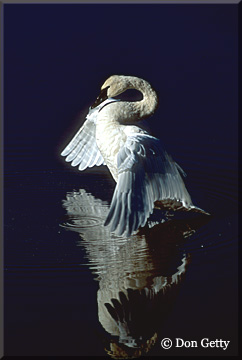
This week on BirdNote, we peer into the world of the Black Oystercatcher, Haematopus bachmani; learn about the eagle eye (the website includes an amazing photo of a Golden Eagle taken by my bird pal, Don Bacchus); soar along with Red-tailed Hawks, Buteo jamaicensis; celebrate the “snowbird,” the Dark-eyed Junco, Junco hyemalis; and also they discuss the return from the North of the Trumpeter swan, Cygnus buccinator, and Tundra Swan, Cygnus columbianus (a swan is pictured). BirdNote programs are two-minute vignettes that incorporate the rich sounds of birds provided by Cornell University and by other sound recordists, with photographs and written stories that illustrate the interesting -- and in some cases, truly amazing -- abilities of birds. Some of the shows are Pacific Northwest-oriented, but many are of general interest. BirdNote can be heard live, Monday through Friday, 8:58-9:00AM in Western Washington state and Southern British Columbia on KPLU radio and now also in North Central Washington state on KOHO radio. All episodes are available in the BirdNote archives, both in written transcript and mp3 formats, along with photographs. [mp3/podcast].
Miscellaneous Birds:
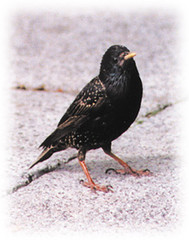 Seattle is experiencing a bird problem. Nona Raybern thought she’d lucked out a couple of weeks ago when she found a parking spot on Fourth Avenue just a half block from the Starbucks at Westlake Center, where she works as a barista. But, like all good things that happen in a person’s life, this parking space came with a price. At precisely 5 pm, about 200 small black European Starlings, Sturnus vulgaris (pictured), that had been circling over Macy's, landed in the trees, filling the air with the sound of chirps and the pings of poop hitting windshields. Raybern later discovered her mistake. “I didn't know whether to laugh or cry. I just got inside [my car] in disbelief. On the drive home, everyone was staring and pointing. I had to run it through the car wash twice, so it ended up costing me $25,” Raybern complained. The starling problem has been worse in some cities in the Midwest and the East Coast, “where they've suffered an invasion numbering in the millions,” said Roy Francis, the city's manager of urban forestry. Some have poisoned the birds; others have played loud noises and hung colorful streamers in the trees to mimic predators. Nothing has worked. But other people are philosophical. For Brahim Mahdoubi, bird poop is the price to pay for living in a city intertwined with nature. He parked his black Mercedes under a tree with about 50 birds perched in it, knowing what he’d find when he came back. When questioned about this, he shrugged, looked up at the tree and said: “Look at all the birds. How lucky are we to see that beauty?” But there is a bright spot in all this. More people are taking the bus to work.
Seattle is experiencing a bird problem. Nona Raybern thought she’d lucked out a couple of weeks ago when she found a parking spot on Fourth Avenue just a half block from the Starbucks at Westlake Center, where she works as a barista. But, like all good things that happen in a person’s life, this parking space came with a price. At precisely 5 pm, about 200 small black European Starlings, Sturnus vulgaris (pictured), that had been circling over Macy's, landed in the trees, filling the air with the sound of chirps and the pings of poop hitting windshields. Raybern later discovered her mistake. “I didn't know whether to laugh or cry. I just got inside [my car] in disbelief. On the drive home, everyone was staring and pointing. I had to run it through the car wash twice, so it ended up costing me $25,” Raybern complained. The starling problem has been worse in some cities in the Midwest and the East Coast, “where they've suffered an invasion numbering in the millions,” said Roy Francis, the city's manager of urban forestry. Some have poisoned the birds; others have played loud noises and hung colorful streamers in the trees to mimic predators. Nothing has worked. But other people are philosophical. For Brahim Mahdoubi, bird poop is the price to pay for living in a city intertwined with nature. He parked his black Mercedes under a tree with about 50 birds perched in it, knowing what he’d find when he came back. When questioned about this, he shrugged, looked up at the tree and said: “Look at all the birds. How lucky are we to see that beauty?” But there is a bright spot in all this. More people are taking the bus to work. 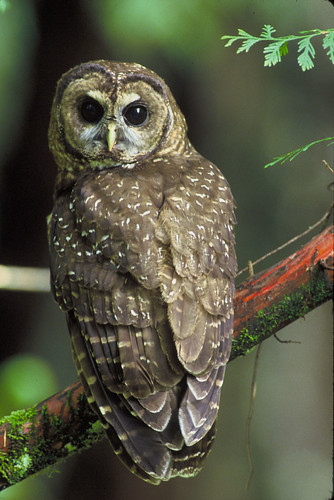 Isn’t it interesting how birds lose when corporate profits are threatened? For example, when a Washington state board gathered this week to pretend how to best protect endangered spotted owls, Strix occidentalis caurina (pictured), the man in charge was a Department of Natural Resources official who had privately met with timber industry executives and promised to soften proposed regulations. An internal timber industry memorandum obtained by the Seattle Post-Intelligencer outlines how Pat McElroy, chairman of the Forest Practices Board, agreed to eliminate a key DNR staff recommendation to be considered today. The memo also suggests that McElroy had planned to alter his agency’s recommendations without telling others involved in the talks, such as environmentalists and tribal leaders. “This just shows how stacked the deck is against a credible public process,” said Peter Goldman of the Washington Forest Law Center, which represents environmentalists in timber lawsuits. “We've been working for two years to convince them what they need to do to protect owls. This is what the DNR staff came up with, and it almost went into the trash.” GrrlScientist observes; In view of shenanigans like this, how can any sane and rational corporate droid not understand that the public is fully justified in their mistrust of corporations when environmental issues or endangered species are at stake?
Isn’t it interesting how birds lose when corporate profits are threatened? For example, when a Washington state board gathered this week to pretend how to best protect endangered spotted owls, Strix occidentalis caurina (pictured), the man in charge was a Department of Natural Resources official who had privately met with timber industry executives and promised to soften proposed regulations. An internal timber industry memorandum obtained by the Seattle Post-Intelligencer outlines how Pat McElroy, chairman of the Forest Practices Board, agreed to eliminate a key DNR staff recommendation to be considered today. The memo also suggests that McElroy had planned to alter his agency’s recommendations without telling others involved in the talks, such as environmentalists and tribal leaders. “This just shows how stacked the deck is against a credible public process,” said Peter Goldman of the Washington Forest Law Center, which represents environmentalists in timber lawsuits. “We've been working for two years to convince them what they need to do to protect owls. This is what the DNR staff came up with, and it almost went into the trash.” GrrlScientist observes; In view of shenanigans like this, how can any sane and rational corporate droid not understand that the public is fully justified in their mistrust of corporations when environmental issues or endangered species are at stake?Okay, this week has made me feel really cranky, so I had to cheer myself by ending this issue of Birds in the News with a humorous birds-in-clothing story. Incredibly, this story is true. According to this news story, a 35-year-old woman near Fort Myers was charged this month with stealing a Greenwing Macaw, Ara chloroptera (pictured at top), from a bird farm by hiding the bird in her bra. How on earth did she do this? “When you got a thousand birds, it’s hard to keep track of all of them,” said Hobbs Guenther, the owner of Baby Exotic Birds. The suspect, Jill Knispel, 35, of Englewood, Florida, was employed as a bird feeder at Guenther’s farm when she made off with the rare parrot, which can grow to a height of 4 feet. That seems like a lot of bird to stuff in a bra, even by today’s augmentation standards. “She didn't take it when it was full grown,” Guenther said. “It was just a baby. Only about two inches.” Apparently, Knispel’s mouth also runneth over, otherwise, Guenther might have never known. After Knispel stole the bird, raised it, and traded it for a Karmann Ghia car, she then, being a genius, blabbed about it to a woman who happened to be Guenther’s former girlfriend. Ooops.
Thanks to my bird pals; Jamie, Caren, Mary, Eddie, Pat, Debi, Fred, Ellen and Ron for some of the links you are enjoying here. Thanks also to Devery for financial support for Birds in the News.
tags: Birds in the News, ornithology, birds, avian, newsletter
Survival Job applications: 4 (shotgun method, again. I actually have no idea if any adjunct positions exist at any of these schools)
© 2004, 2005, 2006 by GrrlScientist











5 Peer Reviews:
So . . . a diet high in lipids makes us smarter? Add that to Cliff Clavin's Buffalo Theory of Alcohol Consumption, and we've a good reason to embrace the fat-laden food of the holiday season and drink more! Science matters!
Seriously, though, you've given us some great articles here lately! Given the wealth of info on evolution provided by birds, we'd live an impoverished life without them.
About that 4 foot high macaw . . . is it standard to refer to a bird's height as tip-of-head to tip-of-tail? Length, I think, would be a better description. I shudder to think of a macaw standing 4 feet high, as the phrase suggests. If proportional, their brains would be 4x larger, and imagine the size of those beaks! My b&g would be snapping coconuts instead of Brazil nuts (and perhaps arguing w/ me about Lewontin)!
Joel the Bowerbird; thanks for reading! I also thank the people out there who $upport Birds in the News, too! It really means a lot!
Jamie; I doubt a diet that is high in lipids will make humans smarter, but a high-lipid diet apparently is necessary for proper brain development for red-legged kittiwakes and (probably) other seabirds.
I agree with you that our world and our understanding of science is greatly enriched by birds. And showing the public the tremendous importance of birds is one of the main objectives of Birds in the News.
To answer your question, it is not technically correct to refer to a macaw as standing four feet high -- they are four feet long from tip of tail to beak -- but I love quoting news stories when they say that because it creates an amusing mental image for me, and I wonder if it does so for my readers, too.
I also appreciate the mental image of a human arguing about Lewontin with a giant parrot. Do you suppose the bird would bite your lip off if you disagreed?
GrrlScientist
Heh. My macaw buddy solves our arguments by slinging claw-fulls of fresh steamed veggies up onto the ceiling. It's amazing the leverage she can attain with her short 'lil legs and feets.
Four foot tall parrots would be great, though (scary, but great). We could probably teach them the gist of Mayr's "What Evolution Is" and Zimmer's "Evolution," and send them off to Kansas to explain it to the school board there. Pity de fool who disagrees with a giant pssitacine!
You do a damn fine job with BITN, Dr. Hedwig. I take much of what you provide here and disseminate it to my friends and family, many of whom are evolution deniers, but I manage to walk the fine line out of unfortunate necessity. Your students, I bet, are privileged to have you as their teacher. Keep that in mind in your job search. Biophilia and hugs all around . . .
Jamie; thanks for your vote of confidence. I have another evolution essay coming this week, and will probably have an interview that will hopefully be published tomorrow (we shall see).
Regarding your comment, I would like to believe that my students are priviledged that I am their professor .. most of them seem to think so, although the story that I could tell about how I learned this from them is sort of .. difficult for me to tell right now. Maybe I'll find the courage to tell it onde day? Unfortunately, my students' convictions have neither changed nor improved the miserable situation that I am currently attempting to deal with.
GrrlScientist
Post a Comment
<< Home